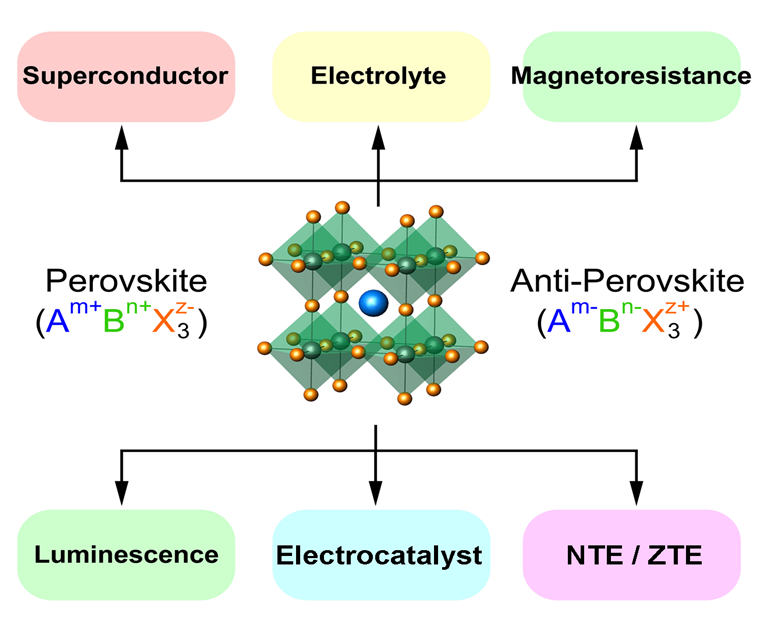Review: Anti-Perovskites with Exceptional Functionalities - Dr. Yonggang Wang
DECEMBER 14
After long-term ploughing and weeding on functional materials with anti-perovskite structure, a joint group of scientists co-led by Dr. Yonggang Wang from HPSTAR, published a review paper on anti-perovskites with exceptional functionalities on Adv. Mater. (doi:10.1002/adma.201905007). Anti-perovskites, as electronically inverted perovskite derivatives inheriting the flexible structural features of perovskites while being rich in cations at X sites, exhibit a diverse array of unconventional properties. However, rather less attention has been paid to these “inverse” analogs. This Review summarized recent advances in novel anti-perovskite materials with exceptional functionalities, including superionic conductivity, superconductivity, giant magnetoresistance and negative thermal expansion. Particularly, a universal strategy for enhancing the performance in anti-perovskites is discussed from the perspective of solid-state chemistry. With more research enthusiasm, anti-perovskites are highly anticipated to be a rising star within functional materials.
Perovskites, named after the Russian mineralogist L. A. Perovski in 1839, comprise materials with the general formula ABX3 with a built-in potential for structural complexity and surprising properties. Perovskites have always been a major player in solid-state chemistry and physics owing to their numerous significant properties. Very recently, the discovery of hybrid perovskites applied as photovoltaic materials has once again stimulated the research field of perovskites. Anti-perovskites can also be described by the formula ABX3, but electronically inverted. From the viewpoint of structure chemistry, anti-perovskites should share the advantages of the perovskite-type structure with traditional perovskites, accommodating diverse elements to form a large family of functional materials. Indeed, anti-perovskites have shown various interesting properties, such as magnetism, ionic conductivity, superconductivity and negative thermal expansion. These exhilarating findings can be highly expected to prompt a new round of development of functional anti-perovskites.
The joint group of scientists from PKU, HPSTAR, SUSTech and UNLV has engaged in the exploration of functional anti-perovskites for a long time. They firstly reported Li-rich anti-perovskites (LiRAP) Li3OX (X = Cl, Br, I) as superionic solid electrolyte (J. Am. Chem. Soc. 2012, 134, 15042) and Na-rich anti-perovskites (NaRAP) Na3OX as potential solid electrolytes for sodium batteries (J. Power Sources 2015, 293, 735). They also studied profoundly on the ion transport mechanism of anti-perovskites by neutron techniques (Inorg. Chem. 2016, 55, 5993), hold the patents on NaRAP solid electrolytes (International patent, WO 2016/026130 A1) and transition-metal doped LiRAPs for cathode applications (US patent, 62115521, 2014), and made great effort to promote the practical application of anti-perovskites in all-solid-state batteries.
In this review, the authors summarized recent explorations of anti-perovskite-type materials, focusing particularly on their crystal structure features and emerging physical properties and functionalities. They presented a general background on the current research status of anti-perovskites and their potential to be a large family of functional materials. Synthesis strategies for bulk and nanosized materials were also discussed. Rather than trying to cover the entire field, this review paper focused on the crystal structure features and emerging functionalities of anti-perovskites. The authors also discussed structural manipulation methods for improving their performance in several fields. Finally, they concluded with an overview of the structure-property relationships of anti-perovskite-type materials, a perspective on the future exploration of new anti-perovskites, and their potential for various practical applications.
“You can play with anti-perovskites just as everything you did with perovskites” said Dr. Yonggang Wang, the leading author of this work. “If there are organic-inorganic hybrid perovskites, I am sure there must be organic-inorganic hybrid anti-perovskites. Likewise, we know perovskites can transform to post-perovskites under high pressure. Scientists have already observed the anti-perovskite to post-anti-perovskite transition under high pressure. It is too late to try it now. But you can think about other ideas on anti-perovskites.”

Caption: Anti-perovskites with exceptional functionalities.
钙钛矿作为世界上最大的功能材料家族,以其多功能性和神秘的科学原理引起了世界范围内极大的研究兴趣。电价倒置的钙钛矿衍生物,反钙钛矿,同样也是一个不可忽视的功能材料家族。事实上,反钙钛矿一方面继承了钙钛矿高兼容的结构特征,另一方面有在X位置上富阳离子的特点,因此表现出各种常规的和非常规的物理化学性质。然而,目前对这些“反钙钛矿”类似物的关注却很少。来自高科、北大和南科大的研究者们合作综述了近年来新型反钙钛矿材料的研究进展及特殊功能,包括超离子导电性,超导性,巨磁电阻,负热膨胀,发光和电化学能量转换等。特别是考虑到钙钛矿结构的可操作性,从结构化学的角度讨论了提高反钙钛矿性能的通用策略。随着研究者们对反钙钛矿材料热情的提高,反钙钛矿有望成为功能材料的一颗新星。该综述发表在Advanced Materials。
